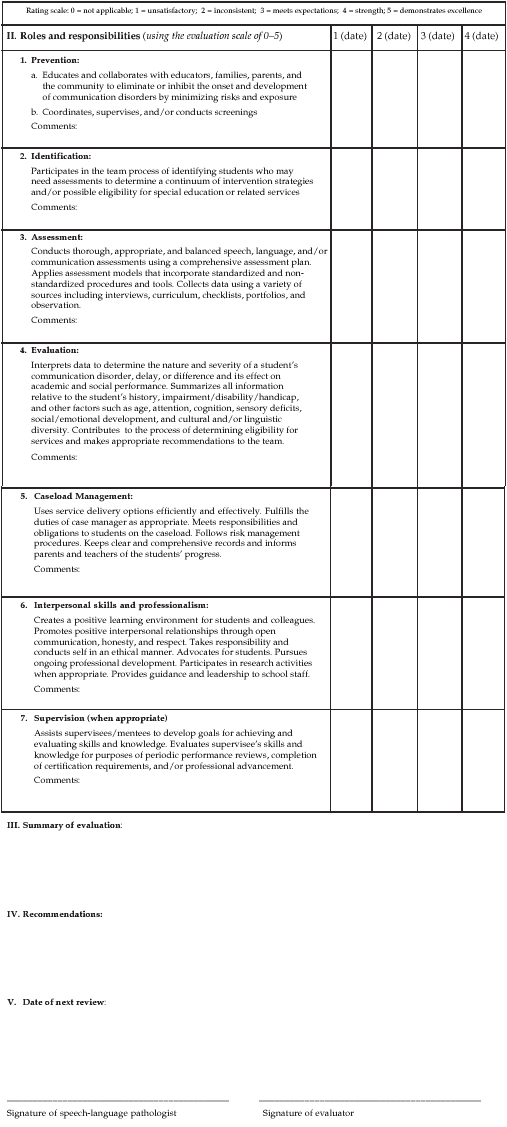Professional Performance Review Process for the School-Based Speech-Language Pathologist
Guidelines
Ad Hoc Joint Committee of Administration and Supervision and School-Based Issues
About this Document
These Guidelines are an official statement of the American Speech-Language-Hearing Association (ASHA). They were developed by the Ad Hoc Joint Committee of ASHA Special Interest Division 11, Administration and Supervision, and Division 16, School-Based Issues. Members of the group were Trici Schraeder (chair), Sheryl C. Amaral, Susan Bartlett, Susan Floyd, Erin Dyer, DeAnne Wellman Owre, Jeri Berman (ex officio, 2005–2006), and Michelle Ferketic (ex officio, 2006). Vice President for Professional Practices in Speech-Language Pathology (2003–2005) Celia Hooper and Vice President for Professional Practices in Speech-Language Pathology (2006–2008) Brian Shulman served as the monitoring vice presidents. The document was approved by ASHA's Legislative Council on August 31, 2006.
Table of Contents
- Background Information and Rationale
- Purposes of Professional Performance Review
- The Role of Self-Reflection in the Professional Performance Review Process
- Formative Process and Summative Process
- Five Steps of the Professional Performance Review Process
- Summary
- References
- Appendix A Self-Reflection Professional Performance Review Instrument for the School-Based Speech-Language Pathologist
- Appendix B Performance Review
- Appendix C Resources Used in Creating the Performance Review & Self-Reflection Instrument
Background Information and Rationale
This document delineates the process of conducting performance appraisals, or evaluations, of the school-based speech-language pathologist (SLP). A primary purpose of this process is to promote professional growth within a system of accountability; further, professional performance review is considered a core feature of quality assurance. In educational settings, the impetus for quality assurance began with modern school reform, a movement that has progressed in three distinct phases across three decades. The first phase grew out of A Nation at Risk, a report published in 1983 by the National Commission on Excellence in Education that focused on issues such as lengthening the school year and requiring more academic courses. The second phase began in the 1990s with a shift in focus to strengthening and validating academic standards. The third phase originated from What Matters Most: Teaching for America's Future ( Danielson, 2001; Moore-Brown & Montgomery, 2001; National Commission on Teaching and America's Future, 1996). This third phase of the modern school reform movement placed a strong emphasis on defining what constitutes quality educators and became one of the building blocks of the No Child Left Behind Act (NCLB) of 2002. NCLB mandated that by the end of the 2005–2006 school year, all public school teachers in the United States must be “highly qualified” for their positions ( U.S. Department of Education, 2005). Thus, this current phase of educational reform is known as the accountability era.
Purposes of Professional Performance Review
The four major purposes of professional performance review are (1) quality assurance, (2) professional development, (3) performance improvement, and (4) feedback ( ASHA, 1993; Danielson, 2001). However, the only purpose “recognized by legislators and policymakers is quality” ( Danielson, 2001, p. 12).
Quality Assurance. The quality of the evaluation instrument influences the quality of the performance review. Implementations of NCLB and the Individuals with Disabilities Education Improvement Act (IDEA) of 2004 have mandated the use of evidence-based practice and accountability by administrators, teachers, and specialists, including SLPs. Many schools have adopted union-negotiated evaluation instruments for performance review. Typically, these instruments used for evaluating classroom teachers have not reflected the unique roles and responsibilities of the SLP, which include prevention, identification, assessment, evaluation, and re-evaluation of communication disorders, differences, and delays; development of individualized educational plans (IEPs) or individualized family service plans (IFSPs); and caseload management, intervention, counseling, transition services, dismissal, supervision, documentation, professional leadership, research, advocacy, and accountability ( ASHA, 2000). Because of the limitations of general assessment tools or protocols used for teachers, it was necessary to create a performance review instrument that could adequately address the professional competencies and workloads that are unique to SLPs in the school setting. For the sake of quality assurance, the Professional Performance Review Process was developed as a mechanism for evaluating the performance of school-based SLPs.
Throughout the country, educational systems have struggled with designing and implementing appropriate appraisal systems that include a component designed to enable teachers and specialists to improve their skills. Frequently, SLPs are not evaluated by someone who has been trained, certified, or licensed in the same discipline. School-based SLPs are often evaluated by an immediate supervisor, principal, or administrator who may not be aware of the various roles and responsibilities that the school-based SLP is required, by federal, state, or local mandates, to perform. In such cases, ASHA ( 1993) recommends that a self-reflection exercise be incorporated into the performance review process:
The 1993 position statement on professional performance appraisal ( ASHA, 1993) stated that professional performance appraisals of SLPs and audiologists engaged in the delivery of clinical services should include an assessment of the clinical skills unique to the employee's profession. This component of the performance appraisal should be conducted by people who hold ASHA certification (and licensure where appropriate) in the employee's professional area. In cases in which organizational structure precludes adoption of this position, participatory approaches (peer evaluations and/or self-evaluations) should be instituted as components of the performance appraisal process.
The need for a comprehensive, user-friendly professional performance review instrument tailored for the school-based SLP is long overdue.
Professional Development. Research suggests that “professional development plays a key role in addressing the gap between teacher preparation and standards-based reform” (Birman et al., p. 28). An effective professional performance review has the power to inform practitioners and performance evaluators as to where to direct their professional development efforts. School districts must be committed to professional development. This is underscored by a statement from the National Joint Committee on Learning Disabilities: “Unless professional development is an integral part of a school district's strategic plan, it cannot meet the learning needs of all students” ( 2000, p. 1). In this era of soaring costs and shrinking school budgets, judicious selection of professional development activities is essential. Few would disagree that SLPs need to learn about current research on learning, but as demands increase, professional development time is a precious commodity ( Magestro & Standord-Blair, 2000). While SLPs are expected to participate in building-level, district-level, or other interdisciplinary professional development initiatives, they also require release time and funding to pursue discipline-specific learning that will result in increased knowledge and skills.
Performance Improvement. Performance improvement is cited as another positive outcome of an effective performance review. Performance improvement is best achieved when the practitioner feels empowered, as summarized in the work of Freire ( 1972, 1985) and Giroux ( 1983, 1985a, 1985b, 1986), who point out that an empowerment perspective has been one of the basic tenets of teacher evaluation. “This perspective purports that change is best accomplished when individuals and groups are free to look critically at what they are doing. The evaluation processes should help participants join together in a quest for an understanding of teaching” ( Gitlin & Price, 1992, p. 61). The focus of performance improvement may vary greatly from professional to professional. For example, the SLP who is completing a clinical fellowship is likely to have a very different focus for performance improvement from the SLP who has many years of experience. A veteran professional may need to focus on acquiring new clinical knowledge and skills to meet challenges unique to his or her workload. As an example, an experienced school-based SLP may need to expand his or her repertoire of strategies for meeting the needs of students with communication disorders who have rare syndromes, low-incidence disabilities, degenerative health conditions, or atypical life experiences. Thus, a performance review exercise must be flexible and responsive to the needs of the individual professional from novice to expert.
Feedback. According to Cain ( 2001), approximately one third of the teaching force across America completing a second year of service does not return for a third year. Many of these disillusioned professionals lose their perspective because they lack feedback. Cain ( 2001) continues, “The situation has become serious enough that centers dedicated to the renewal of teachers have sprung up in several states, and more are in the planning stage” (p. 703). He identified 10 qualities of a renewed practitioner (2001):
-
a philosophical center;
-
a commitment to students, lifelong learning, and school;
-
an awareness of being an integral part of the school;
-
a sense of personal responsibility;
-
a love of life that encompasses his or her professional life;
-
the ability to see all people as individuals;
-
the ability to communicate;
-
a sense of collegiality;
-
a strongly developed sense of leadership; and
-
the ability to separate ego from work.
Feedback may facilitate the growth and development of these 10 characteristics. “By receiving feedback from multiple sources, educational leaders can reassess their skills, address their weaknesses, and become more valuable to their schools and districts” ( Dyer, 2001, p. 35).
The Role of Self-Reflection in the Professional Performance Review Process
Combining a self-reflective process with elements of feedback from an outside evaluator may be the solution to developing a professional performance review process that is relevant for school-based SLPs and also useful for their evaluators. Use of the Professional Performance Review Process, as described in this document, garners all the positive outcomes cited by Cain, Dyer, and Danielson and also ensures that the ASHA position statement on professional performance appraisal ( ASHA, 1993) is upheld. Research on the appraisal process shows strong support for incorporating a self-reflective component into the professional performance review process ( Brown, 2000; McCarthy, 2003; Saras, 2003; Vega-Barachowitz, 2003).
Research on teaching over the past two decades has shown that effective practice is linked to inquiry, reflection, and continuous professional growth ( Brown, 2000; Harris, 1998; McCarthy, 2003; Saras, 2003; Vega-Barachowitz, 2003). The ERIC Digest ( Ferraro, 2000) reviews the concept, levels, techniques, and benefits of reflective practice. It offers a historical overview of reflective practice and how it may benefit teacher professional development, both for pre-service and in-service teachers: “In 1987, Donald Schon introduced the concept of reflective practice as a critical process in refining one's artistry or craft in a specific discipline” (p. 1). He recommended reflective practice as a way for beginners in a discipline to recognize consonance between their own individual practices and those of successful SLPs. As defined by Schon, reflective practice involves considering one's own experiences thoughtfully in applying knowledge to practice while being coached by professionals in the discipline ( Schon, 1996). Reflective practice can be a beneficial form of professional development at both the pre-service and in-service levels of teaching. By gaining a better understanding of their individual teaching styles through reflective practice, teachers can improve effectiveness ( Ferraro, 2000). Stones ( 1994) proposed three important elements for reflection to happen: (1) practical experience, (2) a meaningful knowledge base, and (3) interaction with others. The Professional Performance Review Process incorporates all three.
Formative Process and Summative Process
The Professional Performance Review Process is a formative process as well as a summative process in an objective, improvement-oriented format. Bloom, Hastings, and Madaus ( 1971) were the first authors to define the terms formative process and summative process in the educational arena. They described a formative process as “the use of systematic evaluation in the process of curriculum construction, teaching, and learning for the purpose of improving any of these three processes” (p. 117). The concept continues to be advocated. As stated by Howard and McCloskey, “formative evaluation provides a structure for individualized professional growth through a process of self-assessment, goal setting, and feedback” ( 2001, p. 48). Bloom, Hastings, and Madaus described a summative process as “the type of evaluation used at the end of a term, course, or program for purposes of grading, certification, evaluation of progress, or research on the effectiveness of a curriculum, course of study, or educational plan” ( 1971, p. 117). The concepts of formative and summative assessment processes have been advanced by ASHA's Council on Academic Accreditation in Audiology and Speech-Language Pathology (CAA) and Council For Clinical Certification (CFCC; ASHA, 2001). Together, they form a platform for assessing an individual's acquisition of skills and knowledge believed to be necessary for achieving competency in the areas of preventing, assessing, and treating communication disorders.
Based on this foundation, that is, the combination of the formative and summative procedures, the Professional Performance Review Process uses a two-phased approach to evaluating school-based SLPs. The first phase comprises a formative process during which the SLP conducts a self-study of his or her own knowledge and skills relative to performance indicators for fulfilling the roles and responsibilities of an SLP in educational settings. Here the SLP rates his or her own level of performance using a scale that ranges from 0 to 3, progressing from not applicable (0) to I believe this is an area of strength (3). The individual then evaluates the resulting patterns or trends of this self-evaluation, recognizing areas of strength and deficiencies, and proceeds to develop a plan for addressing them.
The second phase of the performance review is a summative process. The SLP and the outside evaluator—for example, a principal, administrator, or director of special education—engage in open dialogue and participate in an on-site observation or conference where information gathered from all forms of evaluation results in the completion of a one-page performance summary using a 0–5 rating scale. The second phase may be conducted initially with a peer for additional formative growth and then with the outside evaluator as the summative exercise. The one-page performance summary rating system may serve as—
-
a framework to be used during a conference in the absence of an observation;
-
a means to document four separate observations that focus on specific aspects of performance;
-
a cumulative record of four separate, comprehensive reviews throughout a school year;
-
a supplement to a school district's standard assessment instrument that is applied to all its educators;
-
a complement to an evaluation instrument that has been union-negotiated and is already in use in a district; or
-
a format that is consistent with the local school district's policy regarding performance reviews.
The combination of the outcomes from phase 1, using the lengthier self-assessment protocol, and phase 2, using the shorter, one-page performance summary, may provide the SLP with specific information for creating a professional development plan and/or artifacts for a portfolio.
Five Steps of the Professional Performance Review Process
The Professional Performance Review Process consists of a two-phase, five-step procedure that includes self-reflection, self-rating, role definition, open dialogue, and observation and/or conference with evaluator feedback. It comprises a formative as well as a summative assessment by the individual school-based SLP and/or an outside evaluator (e.g., CF supervisor, mentor, peer educator, special educator, regular educator, principal, consumer, administrator, or other appropriate evaluator). The five-step process gives the SLP the opportunity to engage in self-reflection, self-rating, and self-initiated modification of practice before initiating an open dialogue with an outside evaluator. It enables clear definition of roles and expected outcomes preceding relevant and focused dialogue between the evaluator and the individual whose performance is being assessed. The opportunity for the SLP to confer jointly with his or her evaluator is compatible with Danielson's observation that, “As part of many districts' new teacher evaluation systems, educators are building in multiple opportunities for professional conversation. Educators recognize that such conversation promotes reflection on practice and mutual learning” ( 2001, p. 15).
Step 1: Self-Reflection. The school-based SLP first reviews the Self-Reflection Professional Performance Review Instrument performance indicators and the 0–3-point rating scale. Then he or she reflects on the meaning of each performance indicator as it relates to his or her own roles, responsibilities, and workload activities.
Step 2: Self-Rating. The SLP considers his or her strengths, challenges, and needs while rating himself or herself using Professional Performance Review Instrument performance indicators. The rating scale ranges from 0 to 3, progressing from not applicable (0) to I believe this is an area of strength (3).
Step 3: Role Definition. The SLP sets up an on-site observation and/or conference with the outside evaluator, who could be a CF supervisor, mentor, peer educator, special educator, regular educator, principal, administrator, or other designated assessor. The SLP and the evaluator review the steps involved in this assessment process—each defining his or her roles—and discuss the possible use of the outcome(s) of the evaluation.
Step 4: Open Dialogue. Following the on-site observation and/or conference, the SLP and outside evaluator discuss the SLP's strengths, challenges, and needs. During this step, the outside evaluator may be informed of the roles and responsibilities of the SLP and his or her total workload. Work samples may be used to provide evidence of quality.
Step 5: Feedback. Using the 0–5 rating scale, the SLP and outside evaluator complete the one-page summary of the Professional Performance Review Instrument. Their discussion at this point addresses (1) evidence of quality assurance, (2) ideas for professional development, (3) targets for performance improvement, and (4) feedback for positive renewal. Together, they create a professional development plan, develop a timeline, and identify resources for achieving the planned outcomes. The outside evaluator may even become an advocate for the SLP at this stage of the process; for example, the evaluator may document the need for continuing education funding. Documentation and materials resulting from the Professional Performance Review Process may be incorporated into a professional portfolio.
Summary
The need for a professional performance review instrument that is designed for the school-based SLP is long overdue. NCLB and IDEA '04 mandate staffing by highly qualified professionals who engage in evidence-based practices. The Professional Performance Review Process described in this document is a two-stage, five-step process designed to achieve four important outcomes: (1) quality assurance, (2) professional development, (3) performance improvement, and (4) feedback for renewal. Educational research has paved the way for the use of new evaluation approaches such as self-reflection, practitioner empowerment, open dialogue, formative processes, and summative evaluations that are conducted using an objective and evidence-based approach. The results of the Professional Performance Review Process may be one component of a more comprehensive, portfolio-based assessment system.
References
American Speech-Language-Hearing Association. (1993). Professional performance appraisal by individuals outside of the professions of speech-language pathology and audiology. Available from www.asha.org/policy/.
American Speech-Language-Hearing Association. (2000). Guidelines for the roles and responsibilities of the school-based speech-language pathologist. Available from www.asha.org/policy/.
American Speech-Language-Hearing Association. (2001). Guidelines for developing formative assessment plans for implementation of new standards for the Certificate of Clinical Competence. Retrieved May 12, 2005, from https://caa.asha.org/.
Birman, B., Desimone, L., Porter, A., & Garet, M. (2000). Designing professional development that works. Educational Leadership, 57(8), 28–32.
Bloom, B. S., Hastings, J. T., & Madaus, G. F. (1971). Handbook on formative and summative evaluation of student learning. New York: McGraw-Hill.
Brown, J. C. (2000, June). Costs and benefits of reflective supervision. Asha Administration and Supervision, 15-18.
Cain, M. S. (2001). Ten qualities of the renewed teacher. Phi Delta Kappan, 82, 702–705.
Danielson, C. (2001). New trends in teacher evaluation. Educational Leadership, 58(5), 12–15.
Dyer, K. (2001). The power of 360-degree feedback. Educational Leadership, 58(5), 35–38.
Ferraro, J. M. (2000). Reflective practice and professional development. ERIC Digest (ED449120). Retrieved May 12, 2005 from www.ericdigests.org/2001-3/reflective.htm.
Freire, P. (1972). Pedagogy of the oppressed. Harmondsorth, Middlesex, United Kingdom: Penguin Books.
Freire, P. (1985). The politics of education. South Hadley, MA: Bergin and Garvey.
Giroux, H. (1983). Theory and resistance in education: A pedagogy for the opposition. Amherest, MA: Bergin and Garvey.
Giroux, H. (1985a, September). Intellectual labor and pedagogical work: Rethinking the role of teacher as intellectual. Phenomenology and Pedagogy, 3(1), 20–32.
Giroux, H. (1985b, May). Teachers as transformative intellectuals. Social Education, 49, 376–379.
Giroux, H. (1986, January). Critical pedagogy and the resisting intellectual. Phenomenology and Pedagogy, 3(2), 84–97.
Gitlin, A., & Price, K. (1992). Teacher empowerment and the development of voice. In C. Glickman (Ed.), Supervision in transition (pp. 61–74). Alexandria, VA: Association for Supervision and Curriculum Development.
Harris, A. (1998). Effective teaching: A review of the literature. School Leadership & Management, 18(2), 169–183.
Howard, B., & McColskey, W. (2001). Evaluating experienced teachers. Educational Leadership, 58(5), 48–51.
Magestro, P., & Standford-Blair, N. (2000). A tool for meaningful staff development. Educational Leadership, 57(8), 34–35.
McCarthy, M. P. (2003, October). Promoting problem-solving and self-evaluation in clinical education through a collaborative approach to supervision. Asha Administration and Supervision, 20–26.
Moore-Brown, B., & Montgomery, J. (2001). Making a difference for America's children. Eau Claire, WI: Thinking Publications.
National Commission on Excellence in Education. A nation at risk: The imperative for educational reform1983 Washington, DC U.S. Government Printing Office
National Commission on Teaching and America's Future. (1996). What matters most: Teaching for America's future. Washington, DC: U.S. Government Printing Office.
National Joint Committee on Learning Disabilities. (2000). Professional development for teachers [Technical report]. Available from www.asha.org/about/publications/reference-library.
Saras, L. (2003, October). Reflective journals: A tool in a clinical supervision model. Perspectives on Administration and Supervision, 11, 25–26.
Schon, D. A. (1996). Educating the reflective practitioner: Toward a new design for teaching and learning in the professions. San Francisco: Jossey-Bass.
Stones, E. (1994). Reform in teacher education: The power and the pedagogy. Journal of Teacher Education, 45, 310–318.
U.S. Department of Education. (2005). New No Child Left Behind Act flexibility: Highly Qualified Teachers fact sheet. Retrieved May 12, 2005, from www.ed.gov/nclb/methods/teachers/hqtflexibility.html.
Vega-Barachowitz, C. D. (2003, June). Review of the reflective practitioner. Perspectives on Administration and Supervision, 11, 14–15.
Appendix A Self-Reflection Professional Performance Review Instrument for the School-Based Speech-Language Pathologist
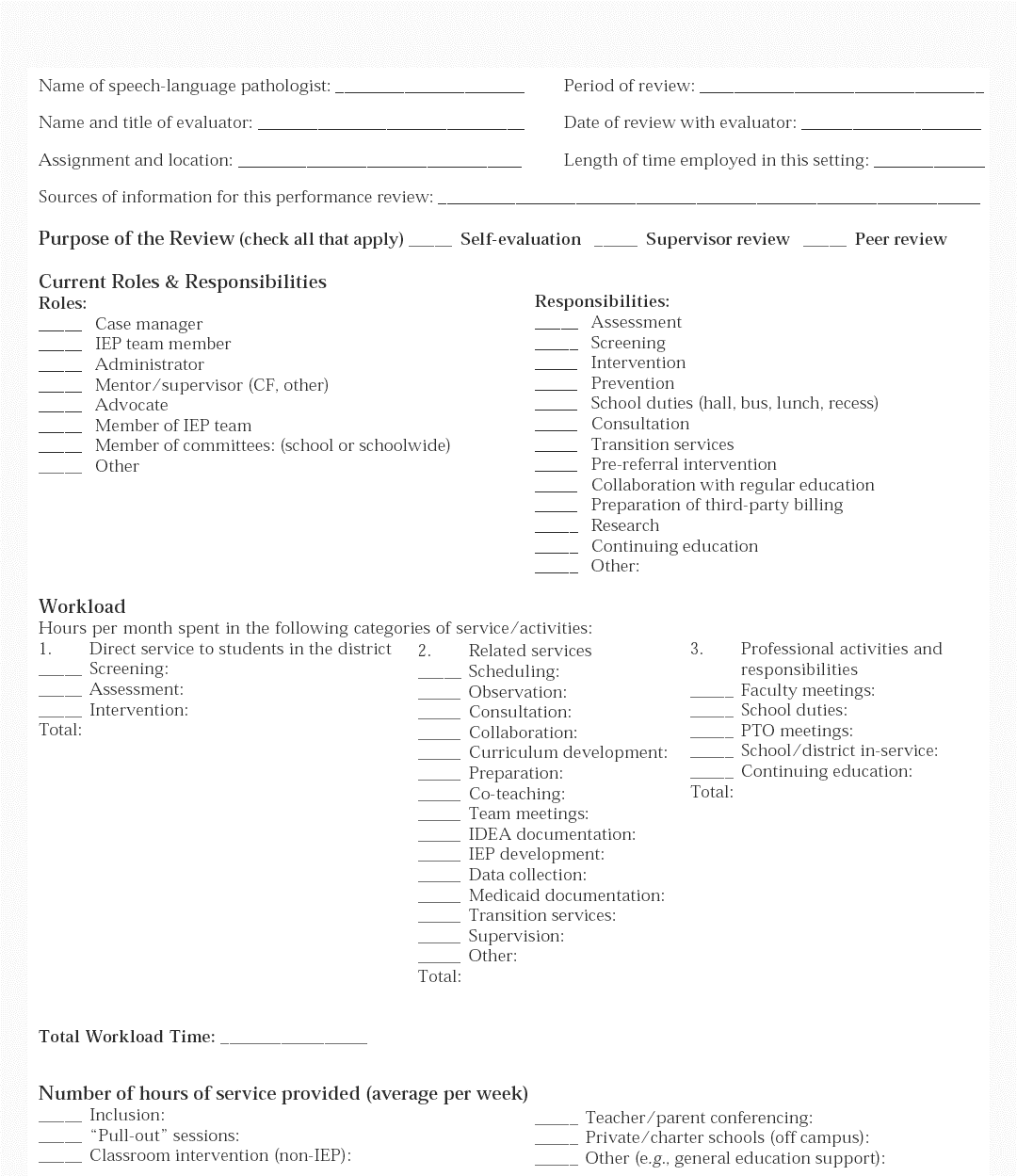
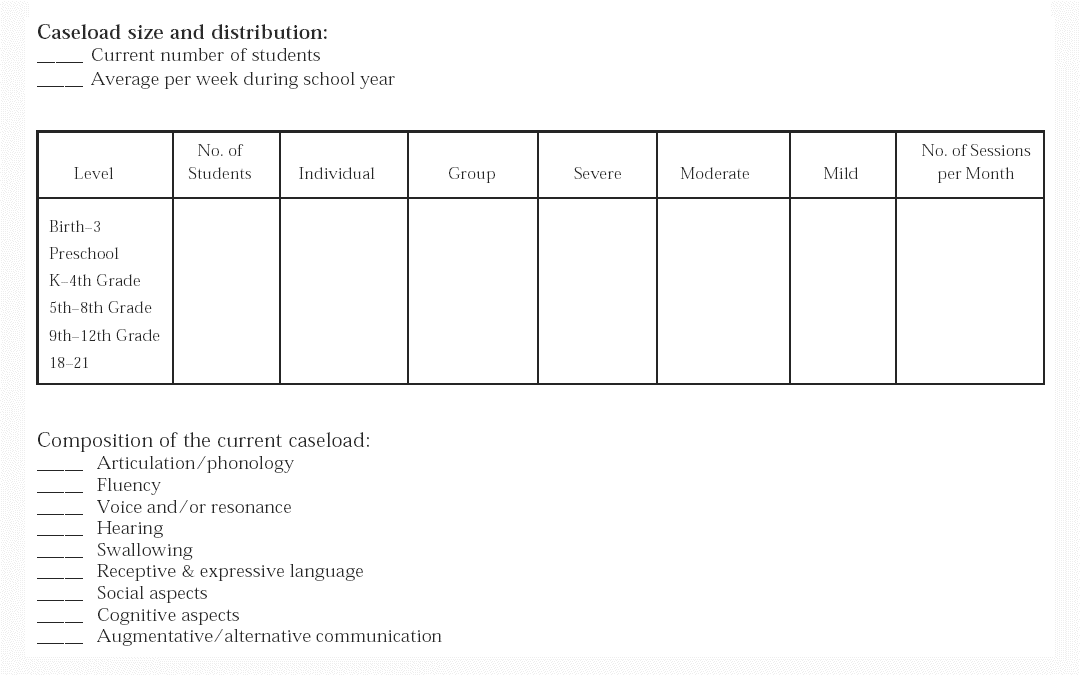
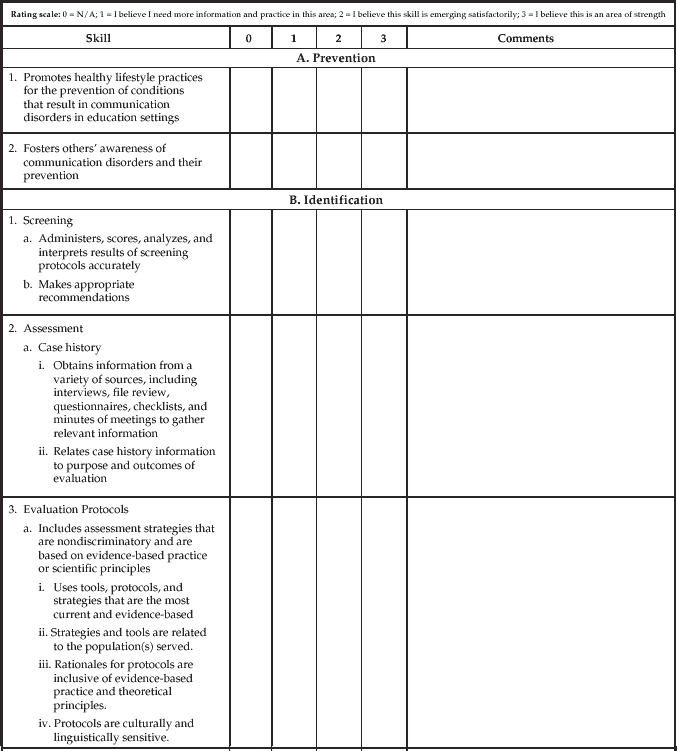
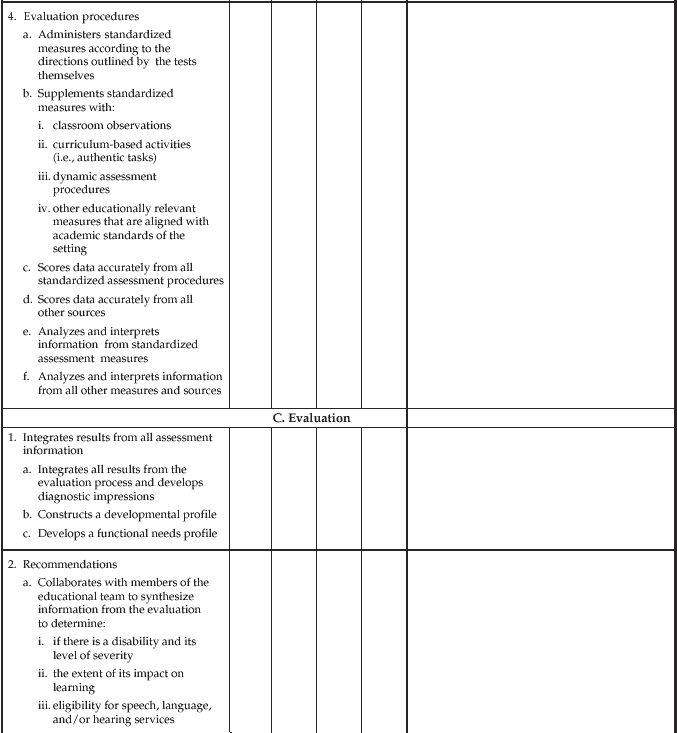
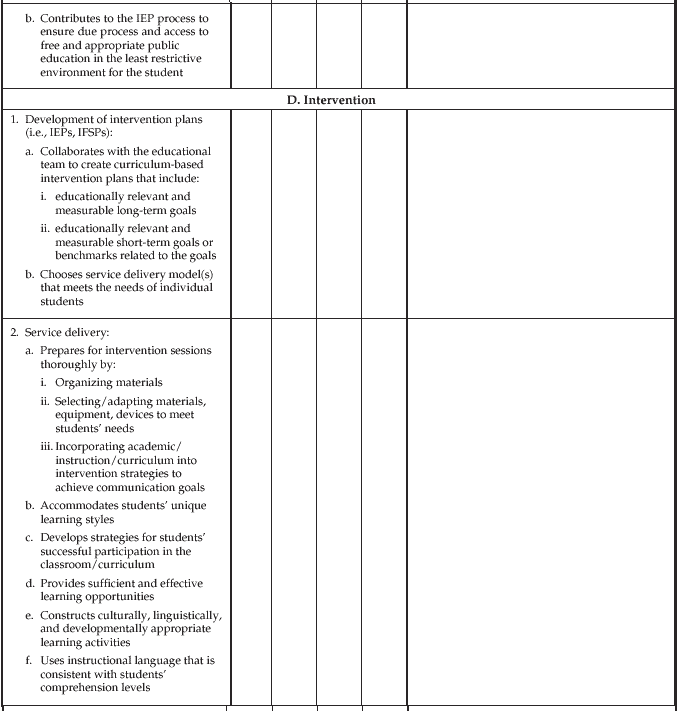
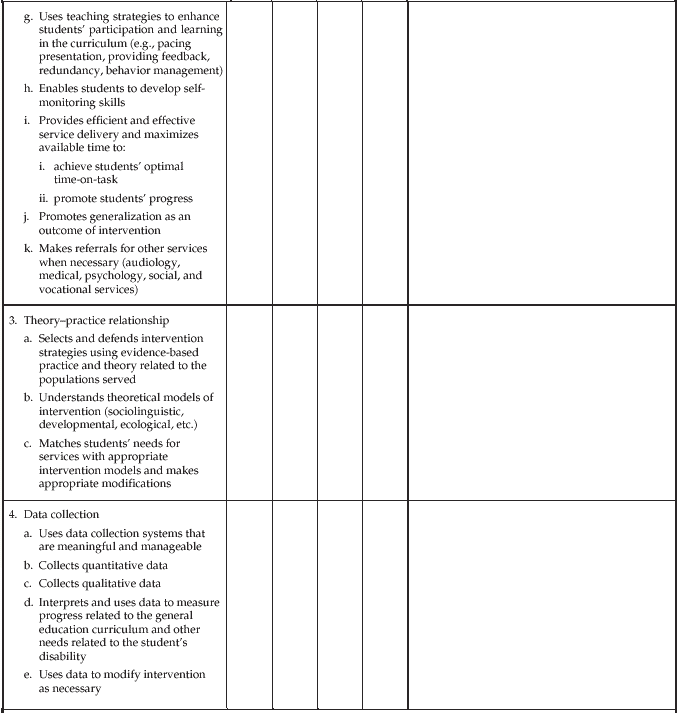
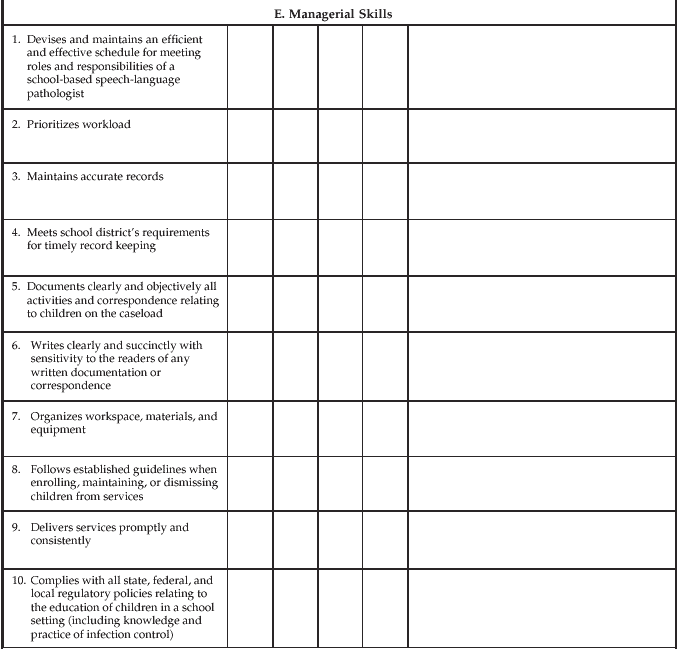
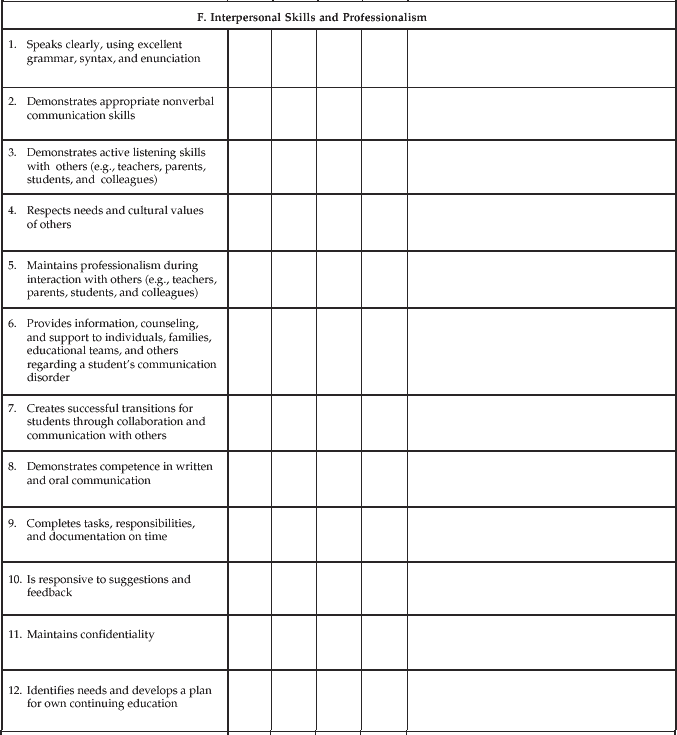
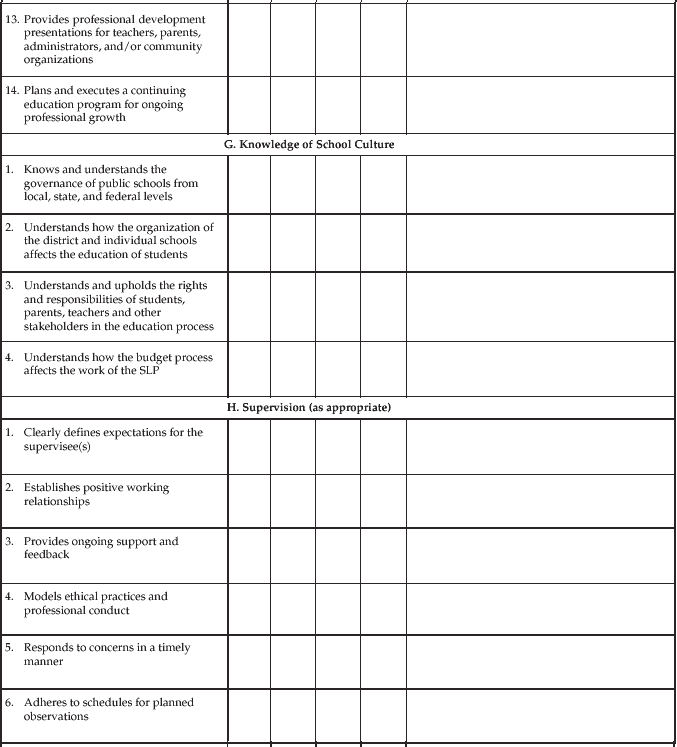
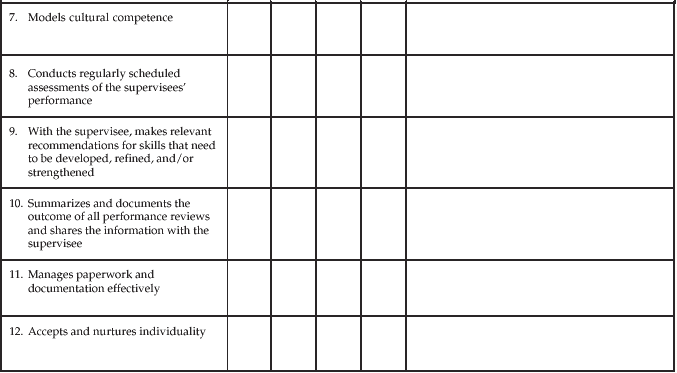
Appendix C Resources Used in Creating the Performance Review & Self-Reflection Instrument
Alabama Department of Education. (2004). Alabama professional education personnel evaluation program evaluation summary report—electronic format speech/language pathologist system. Montgomery, AL: Author.
American Speech-Language-Hearing Association. (1993). Professional performance appraisal by individuals outside the professions of speech-language pathology and audiology. Available from www.asha.org/policy/.
American Speech-Language-Hearing Association. (1999). Guidelines for the roles and responsibilities of the school-based speech-language pathologist. Available from www.asha.org/policy/.
American Speech-Language-Hearing Association. (2001). Roles and responsibilities of speech-language pathologists with respect to reading and writing in children and adolescents: Guidelines. Available from www.asha.org/policy/.
American Speech-Language-Hearing Association. (2001). Roles and responsibilities of speech-language pathologists with respect to reading and writing in children and adolescents: Position statement. Available from www.asha.org/policy/.
American Speech-Language-Hearing Association. (2001). Roles and responsibilities of speech-language pathologists with respect to reading and writing in children and adolescents: Technical report. Available from www.asha.org/policy/.
American Speech-Language-Hearing Association. (2002). A workload analysis approach for establishing speech-language caseload standards in schools: Guidelines. Available from www.asha.org/policy/.
American Speech-Language-Hearing Association. (2002). A workload analysis approach for establishing speech-language caseload standards in schools: Position statement. Available from www.asha.org/policy/.
American Speech-Language-Hearing Association. (2002). A workload analysis approach for establishing speech language caseload standards in schools: Technical report. Available from www.asha.org/policy/.
American Speech-Language-Hearing Association. (2003). A workload analysis approach for establishing speech-language caseload standards in schools: Implementation guide. Rockville MD: Author.
Cobb County School District. (2004). Performance Assessment Instrument for Speech-Language Pathologists Available from Cobb County School District, 514 Glover Street, Marietta, GA 30060; (770) 426-3300..
Cumberland School Department. (2004). Teacher Evaluation Rubric Cumberland Public Schools, 2602 Mendon Road, Cumberland, RI 02864..
Danielson, C. (1996). Enhancing professional practice: A framework for teaching. Alexandria, VA: Association for Supervision and Curriculum Development.
Montgomery County Public Schools. (2004). Speech Pathologists' Performance Observation Form Available from Montgomery County Public Schools, 850 Hungerford Drive, Rockville, MD 20850..
South Carolina Department of Education. (2000). South Carolina System for Assisting, Developing, and Evaluating Professional Teaching. Performance dimensions for speech-language therapists. Available from South Carolina Department of Education, 1429 Senate Street, Columbia, SC 29201.
State of Connecticut Department of Education, Bureau of Special Education and Pupil Services. (1999, revised 2000). Determining eligibility for special education speech and language services. Hartford, CT: Author. Available from State of Connecticut Department of Education, 165 Capitol Avenue, Hartford, CT 06106-1630.
University of Wisconsin—Madison, Department of Communicative Disorders. (2004). Clinical Skills Learner Outcomes Tracking System. Madison WI: Author.
Wake County Public School System. (1989). Performance Appraisal Criteria: Speech-Language Specialist. Available from Wake County Public School System, 3600 Wake Forest Road, Raleigh, NC 27609; (919) 850-1600.
Index terms: performance evaluation, schools
Reference this material as: American Speech-Language-Hearing Association. (2006). Professional performance review process for the school-based speech-language pathologist [Guidelines]. Available from www.asha.org/policy.
© Copyright 2006 American Speech-Language-Hearing Association. All rights reserved.
Disclaimer: The American Speech-Language-Hearing Association disclaims any liability to any party for the accuracy, completeness, or availability of these documents, or for any damages arising out of the use of the documents and any information they contain.
doi:10.1044/policy.GL2006-00275
